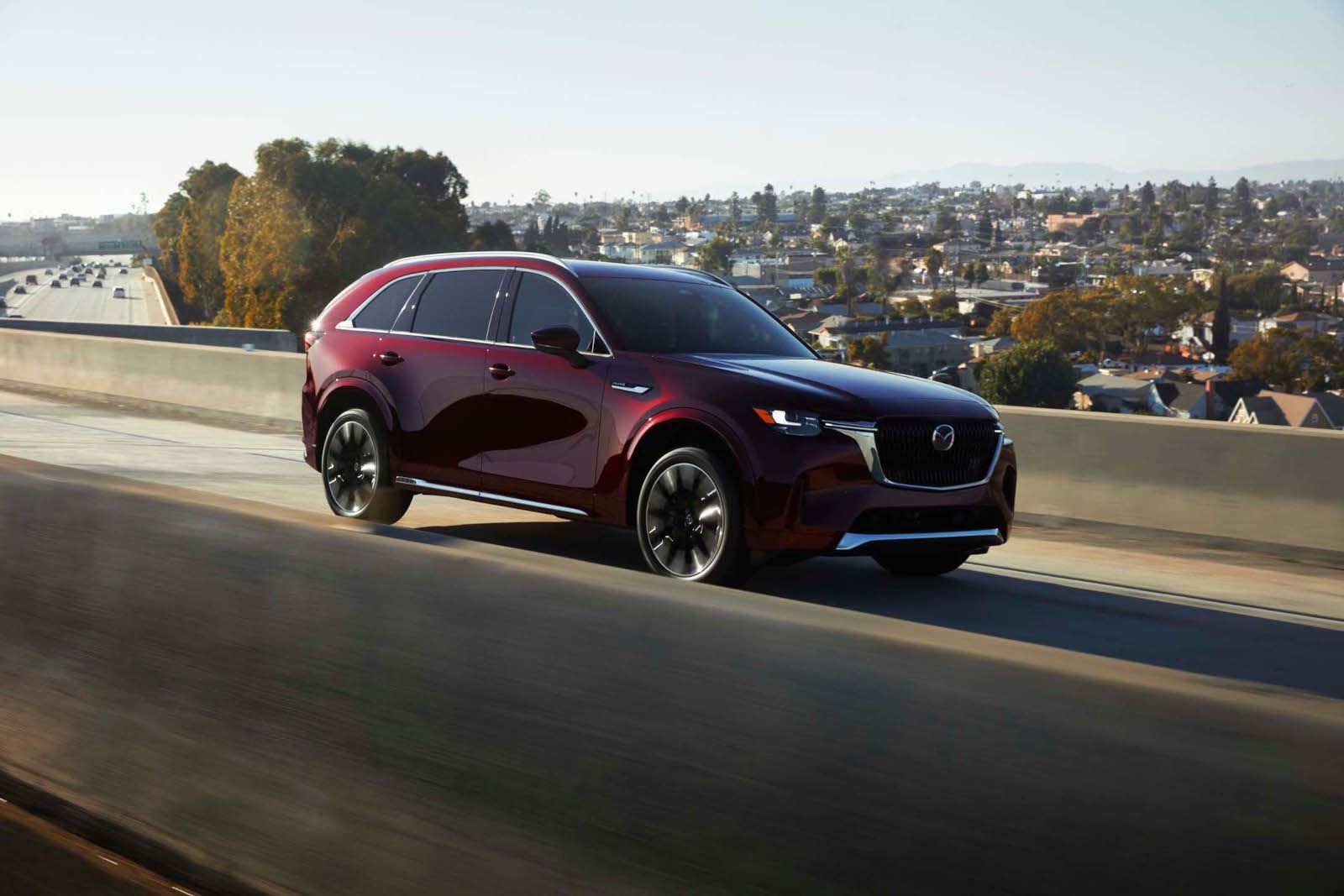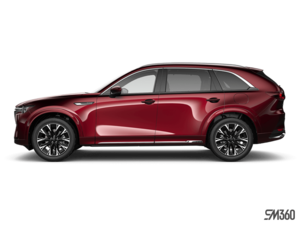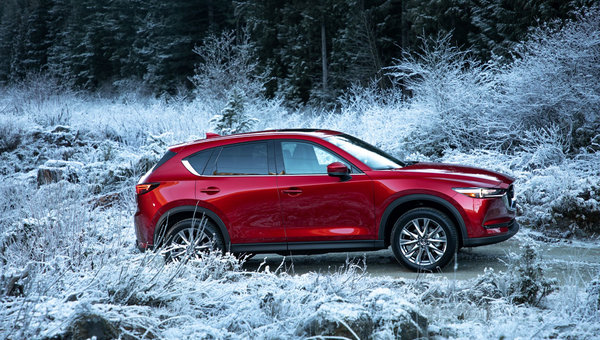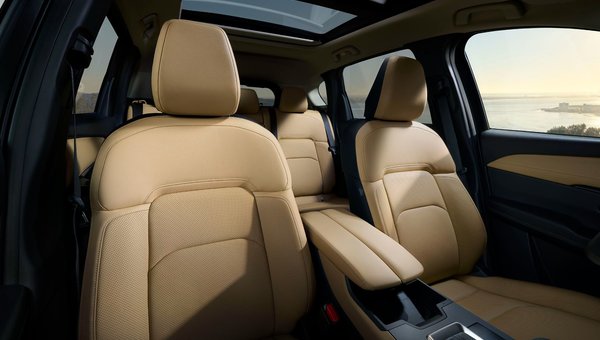What 280 vs. 340 Horsepower Means When Towing and Driving Across the Prairies
October 28 2025,

The 2025 Mazda CX-90 and CX-70 offer their 3.3 L turbocharged inline-six engine in two distinct outputs: a standard 280 hp version running on regular fuel and a high-output 340 hp variant requiring premium. For Saskatchewan drivers who tow campers to regional parks, haul boats across long distances, or simply cover hundreds of kilometres with full passenger loads, understanding the practical difference between these powertrains affects both daily driving experience and long-term operating costs.
Saskatchewan's geography creates specific demands. Highway driving dominates, with sustained speeds of 100-110 km/h across flat terrain where wind resistance and rolling momentum matter more than short acceleration bursts. Towing adds weight and aerodynamic drag. Full passenger loads increase mass. These conditions reveal differences between the two engine outputs that don't show up during brief test drives around Regina.
The Core Specifications
Both engines share the same 3.3 L displacement and inline-six configuration with M-Hybrid Boost technology, but tuning and fuel requirements differ substantially.
Standard Output (280 hp):
- Horsepower: 280 hp @ 5,000–6,000 rpm
- Torque: 332 lb-ft @ 2,000–3,500 rpm
- Fuel requirement: Regular unleaded (87 octane)
- Fuel economy (CX-90): 9.9 L/100 km city / 8.4 L/100 km highway / 9.3 L/100 km combined
- Fuel economy (CX-70): 9.9 L/100 km city / 8.4 L/100 km highway / 9.3 L/100 km combined
High-Output (340 hp):
- Horsepower: 340 hp @ 5,000–6,000 rpm (with 93 octane)
- Torque: 369 lb-ft @ 2,000–4,500 rpm (with 93 octane)
- Fuel requirement: Premium unleaded (91-93 octane recommended)
- Fuel economy (CX-90): 10.3 L/100 km city / 8.5 L/100 km highway / 9.5 L/100 km combined
- Fuel economy (CX-70): 10.3 L/100 km city / 8.5 L/100 km highway / 9.5 L/100 km combined
The 60 hp and 37 lb-ft torque advantage of the high-output engine comes with a 0.2 L/100 km fuel economy penalty and the requirement for more expensive premium fuel.
Towing Capacity Considerations
Towing capacity varies between the CX-90 and CX-70, and between different trim levels of each model.
CX-90 Towing Capacity:
- GS trim (standard engine): 1,588 kg (3,500 lb)
- GS-L/GT/GT-P/Signature trims: 2,268 kg (5,000 lb)
CX-70 Towing Capacity:
- All trims: 2,268 kg (5,000 lb)
The high-output 340 hp engine is standard on GT-P and Signature trims, which also include enhanced towing capability (except the base CX-90 GS). This combination matters when hauling heavier trailers across Saskatchewan's highways.
Highway Passing and Merging: Where Power Shows
Saskatchewan highways feature long straightaways with intermittent slower traffic—farm equipment during harvest, transport trucks, or recreational vehicles. Passing requires sustained acceleration from 90-100 km/h up to 110-120 km/h, often over several seconds and hundreds of metres.
Standard 280 hp Engine
The 280 hp output handles passing maneuvers confidently when the vehicle is lightly loaded. The torque band (332 lb-ft from 2,000–3,500 rpm) provides strong mid-range pull, and the eight-speed automatic downshifts smoothly to access maximum power. For daily driving around Regina or highway trips without trailers, this engine rarely feels strained.
However, when loaded with passengers, cargo, or towing even moderate trailers (2,000-2,500 kg), passing maneuvers require more planning. The engine needs to work harder, often requiring second-gear downshifts where the high-output engine might manage with a single downshift or simply more throttle application in the current gear.
High-Output 340 hp Engine
The additional 60 hp and extended torque band (369 lb-ft from 2,000–4,500 rpm) provide noticeably more reserve power. When towing a 2,000 kg camper on Highway 1 east toward Whitewood or Highway 11 north toward Saskatoon, the high-output engine maintains highway speeds with less throttle input and passes slower traffic more decisively.
The wider torque plateau (extending 1,000 rpm higher than the standard engine) means the engine stays in its power band across a broader range of driving situations. This reduces transmission hunting—the tendency to downshift, upshift, then downshift again when maintaining speed on undulating roads or passing multiple vehicles.
Fuel Costs: Calculating the Premium Fuel Penalty
Saskatchewan fuel prices as of October 2025 show premium fuel costs approximately $0.15-0.20 per litre more than regular unleaded. Combined with slightly lower fuel economy, the high-output engine increases operating costs measurably.
Annual Fuel Cost Comparison (based on 20,000 km/year, typical Saskatchewan driving):
|
Scenario |
Standard (280 hp) |
High-Output (340 hp) |
Annual Difference |
|---|---|---|---|
|
Fuel economy (combined) |
9.3 L/100 km |
9.5 L/100 km |
— |
|
Fuel type |
Regular ($1.45/L) |
Premium ($1.62/L) |
— |
|
Annual litres consumed |
1,860 L |
1,900 L |
+40 L |
|
Annual fuel cost |
$2,697 |
$3,078 |
+$381 |
The high-output engine costs approximately $380-$400 more per year in fuel for typical Saskatchewan driving patterns. This figure increases when towing frequently, as loaded vehicles consume more fuel and amplify the difference between regular and premium prices.
Towing Performance: Real-World Scenarios
Light Towing (Under 1,800 kg): Utility Trailers, Small Boats
Both engines handle light towing without strain. A utility trailer loaded with equipment or a 16-foot fishing boat on a lightweight trailer weighs well under maximum capacity. The standard 280 hp engine provides adequate power for highway cruising and passing when necessary.
The high-output engine offers easier passing and slightly better fuel economy under load—counterintuitively, the more powerful engine works less hard to maintain speed, potentially offsetting some of its fuel cost penalty during towing.
Medium Towing (1,800-2,300 kg): Travel Trailers, Larger Boats
This range represents typical travel trailers (20-24 feet) or larger boats on tandem-axle trailers—common for Saskatchewan families heading to Katepwa Lake, Last Mountain Lake, or Cypress Hills Provincial Park.
The standard 280 hp engine manages these loads but requires more attention during passing maneuvers. Wind resistance from a travel trailer's profile adds significant drag, and the engine works noticeably harder to maintain 100-110 km/h highway speeds, particularly when headwinds are present (common on Prairie highways).
The high-output 340 hp engine handles this weight range confidently. Passing slower vehicles feels secure, and maintaining speed in headwinds or on slight grades doesn't require excessive throttle. The additional torque reduces transmission downshifting frequency, creating a more relaxed towing experience over long distances.
Heavy Towing (2,300-2,268 kg Maximum): Larger Travel Trailers
At or near maximum capacity, the difference between engines becomes pronounced. A 25-foot travel trailer with full water and propane tanks can approach 2,200 kg—close to the 2,268 kg limit available on higher CX-90 and all CX-70 trims.
The standard 280 hp engine can tow this weight legally and safely, but extended highway driving requires careful speed management and early passing planning. The engine operates near its upper performance range, and fuel economy degrades noticeably.
The high-output 340 hp engine maintains better composure at maximum capacity. Highway cruising speed stabilizes more easily, passing maneuvers feel more controlled, and the engine doesn't exhibit the strain that the standard engine shows at this weight level.
M-Hybrid Boost: Supporting Both Engines
Both power outputs include M-Hybrid Boost, a 48-volt mild-hybrid system that provides 16.9 hp and 113 lb-ft of torque during acceleration. This electric assist improves throttle response from stops and supplements power during acceleration, benefiting both engines equally.
The system's contribution matters most during:
- Starting from stops with heavy loads or trailers
- Accelerating from highway on-ramps with trailers in tow
- Maintaining speed during brief grades or headwind surges
While the electric motor doesn't fundamentally change the power difference between the two engine outputs, it improves both engines' low-speed responsiveness and reduces the perceptual gap during stop-and-go driving.
Daily Driving Without Trailers: Does 340 hp Matter?

For Saskatchewan drivers who tow infrequently or not at all, the question becomes whether the high-output engine justifies its cost for daily driving alone.
Around Regina: City Driving
City driving rarely reveals the difference. Both engines provide ample power for merging onto Ring Road, navigating Vic Ave traffic, or accelerating from stoplights. The M-Hybrid Boost system gives both engines immediate throttle response in urban scenarios.
Highway Cruising: Long-Distance Driving
On sustained highway drives—Regina to Saskatoon (260 km), Regina to Brandon (220 km), or Regina to Medicine Hat (330 km)—the high-output engine provides a more relaxed cruising experience. The additional torque means less throttle input to maintain speed, and passing slower vehicles feels effortless rather than requiring planning.
However, the standard 280 hp engine handles these drives competently. The difference is one of refinement and reserve power rather than capability. Most drivers without towing requirements find the standard engine entirely adequate for Saskatchewan highway driving.
Fully Loaded: Passengers and Cargo
With eight passengers and luggage (CX-90) or five passengers with substantial cargo (CX-70), the high-output engine's advantage becomes more apparent. A fully loaded CX-90 with eight adults and vacation gear can exceed 2,400 kg total weight. The additional 60 hp maintains better performance under these conditions, particularly during highway passing or navigating slight grades.
Trim Availability and Package Considerations
The high-output 340 hp engine is standard on specific trims:
CX-90:
- GT-P and Signature trims include the high-output engine
- These trims also include premium features: Nappa leather, ventilated seats, 21-inch wheels, enhanced safety technology
CX-70:
- GT-P and Signature trims include the high-output engine
- Similar premium feature sets as CX-90 equivalents
Buyers cannot option the high-output engine into lower trims, meaning the decision to upgrade power requires accepting higher trim levels with additional features and corresponding price increases. The engine upgrade comes bundled with luxury and technology enhancements, not as an isolated powertrain choice.
Fuel Economy in Real-World Saskatchewan Conditions
Official fuel economy ratings provide baseline comparisons, but Saskatchewan driving conditions affect actual consumption.
Factors Affecting Fuel Economy:
- Wind: Prairie headwinds increase consumption for both engines, but the high-output engine's extra torque may reduce the need for aggressive throttle inputs that spike consumption
- Temperature: Extreme Saskatchewan winters (-30°C to -40°C) reduce fuel economy for all engines during warm-up periods and increase idle time for cabin heating
- Highway Speeds: Sustained 110 km/h cruising increases consumption compared to 100 km/h, affecting both engines similarly
- Towing: Trailer drag can double fuel consumption for both engines, with the standard engine potentially showing slightly higher increases under heavy loads
Real-world reports suggest both engines achieve close to their rated highway fuel economy during unloaded summer driving, with winter conditions adding approximately 1.5-2.0 L/100 km to combined figures.
Decision Framework: Which Engine Makes Sense?
Choose the Standard 280 hp Engine If:
- Towing is infrequent or limited to lighter loads (under 1,800 kg)
- Most driving is daily commuting or highway trips without trailers
- Fuel cost management is a priority
- Lower trim levels provide adequate features for your needs
- Regular unleaded fuel availability is better in your typical driving areas
Choose the High-Output 340 hp Engine If:
- Regular towing of medium to heavy trailers (1,800-2,268 kg)
- Frequent long-distance highway driving with full passenger and cargo loads
- Premium fuel costs are acceptable for improved performance and towing capability
- Higher trim features (Nappa leather, advanced safety tech, premium audio) align with your preferences
- You prioritize effortless passing power and performance reserve
Both Engines in Saskatchewan Context
Saskatchewan's geography suits both engines well. Flat terrain means minimal elevation changes that would otherwise stress engines during towing. Long, straight highways allow safe passing when clear sightlines appear. The Prairie environment doesn't include steep mountain grades where power differences become critical for safe towing.
However, the distances involved mean small differences in comfort and capability accumulate over hundreds of kilometres. A slightly easier passing maneuver repeated dozens of times during a 400 km towing trip reduces driver fatigue and improves confidence.
The 2025 CX-90 and CX-70 equipped with either the 280 hp or 340 hp inline-six engine deliver capable performance for Saskatchewan driving. The decision between them hinges on towing frequency, load weights, trim feature preferences, and fuel cost sensitivity. Visit Regina Mazda to experience both engines during test drives that simulate your typical usage—including loaded driving and towing scenarios when possible—to determine which powertrain configuration best suits your Saskatchewan driving needs.





